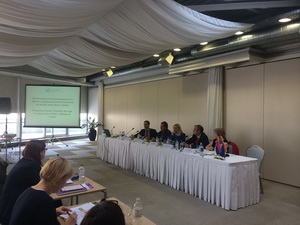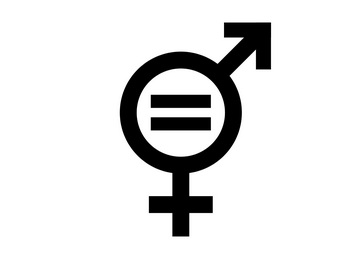
The Social Inclusion and Poverty Reduction Unit, in cooperation with the European Institute for Gender Equality and the Statistical Office of the Republic of Serbia, organised an event entitled “Promoting Gender Equality through Evidence-based Policy Making in Serbia” on 14th and 15th October 2014. The conference was aimed at promoting evidence-based policy making in the sphere of gender equality, as well as sharing experiences between Serbia and the EU. An additional objective concerned the development and adoption of the Gender Equality Index in Serbia. Special guests included Deputy Prime Minister and Minister of Construction, Transport and Infrastructure Zorana Mihajlović, H. E. Ambassador of the EU to Serbia Michael Davenport and European Institute for Gender Equality Head of Operations Therese Murphy and Insitute’s experts .
 On the second day of the event, 15 October, a training programme for statisticians and experts on gender statistics and data for the development of the Gender Equality Index for Serbia was held by experts Dr Anna Rita Manca and Dr Irene Riobóo-Lestón from the European Institute for Gender Equality.
On the second day of the event, 15 October, a training programme for statisticians and experts on gender statistics and data for the development of the Gender Equality Index for Serbia was held by experts Dr Anna Rita Manca and Dr Irene Riobóo-Lestón from the European Institute for Gender Equality.
The Gender Equality Index is a unique measurement tool that converts the complexity of gender equality, as a multi-dimensional concept, into a user-friendly and easily interpretable measure by means of statistical methods. It is formed by combining gender indicators, according to a conceptual framework, into a single summary measure. It consists of six core domains (work, money, knowledge, time, power and health) and two satellite domains (intersecting inequalities and violence). More information on the Index can be found on the website of the European Institute for Gender Equality.
The Gender Equality Index measures gender equality between men and women in all European Union Member States on a scale of 0 – full inequality to 100 – full gender equality. The Index measures the gender gap in relation to the average level of achievement in a given domain, while ensuring that the gender gap cannot be regarded as positive where it indicates an adverse position for both women and men.
Reasons for the Introduction of the Gender Equality Index:
- To ensure sustainable measurement of gender equality with easily comprehensible and communicable results;
- To facilitate comparisons of Serbia to EU Member States through an adjusted composite indicator used for measuring gender equality in the European Union;
- To provide decision makers with a support instrument in assessing how far our country has progressed on the path to achieving gender equality;
- To facilitate important comparisons of different priority domains of gender equality;
- To measure achievements in the area of gender equality over time;
- To enable gender equality policy making based on the data on the status of gender equality in Serbia.
Conclusions:
- Gender equality is an imperative for society and the community and is aimed at economic growth and social cohesion;
- The Government of the Republic of Serbia will set gender equality as a priority and all ministries will be involved in the efforts aimed at achieving gender equality;
- Gender equality is a key EU principle and Serbia’s obligation on the European integration path;
- Gender equality is a horizontal area that should become an integral part of the policies implemented and it should be coordinated at the national level;
- The existence of specific programmes on promoting gender equality and achieving equality between women and men is essential;
- The Gender Equality Index is a key instrument in policy making from the gender equality perspective during the European integration process. It is important that Serbia starts working on defining the indicators and adopt the Index in order to implement evidence-based policies aimed at advancing gender equality and equalising women’s rights compared to men’s, in particular in the spheres of work and decision making. Therefore, it is important for Serbia to use the same conceptual framework as it is used by EU member states to ensure a sufficient degree of comparability with the EU member states, as well as sounder benchmarking of gender equality in Serbia;
- During the production of the Gender Equality Index for Serbia, a need to develop a specific satellite domain might occur in order to meet some particular need in relation to the national context;
- By timely production of a national Gender Equality Index, Serbia will become the first country outside of the EU-28 to have done it;
- Cooperation should be continued among all national and local institutions, civil society organisations, international organisations, the European Union and, above all, the European Institute for Gender Equality.
Main Challenges to the Introduction of the Gender Equality Index in Serbia
One of the greatest challenges, identified during the two-day event “Promoting Gender Equality through Evidence-based Policy Making in Serbia”, in the process of forming the Gender Equality Index in Serbia lies in the availability of the data required to calculate it.
In the process of accession to the European Union, the Republic of Serbia is required, amongst other things, to adapt statistical reporting to European standards. This process has been launched and, owing to the efforts so far, Serbia has LFS and SILC data, which constitute a significant proportion of the data sources used for the calculation of the Gender Equality Index in the EU.
Unfortunately, Serbia still does not participate in all surveys carried out at the European Union level (such as the Structure of Earnings Survey, the European Working Conditions Survey and the Women and Men in Decision Making survey) which also represent data sources for the Gender Equality Index.
On the other hand, Serbia has certain national data (such as the data from education, vital and earnings statistics, as well as the survey “Time Use in the Republic of Serbia”), which could not be included in the Index by the European Institute for Gender Equality since comparable data were not available in all Member States. Aspiring to have this important composite index, and in view of the available data and potentially useful indicators, Serbian experts will select the most appropriate indicators to be included in the calculation of the Gender Equality Index.
Data availability at the regional and/or municipal level should also be taken into account in selecting the indicators to be used in the calculation. Considering that Serbia will develop a country-specific Gender Equality Index, its formation at the regional level should be considered, if formation at the local government level is not possible. Such coverage would provide a significant source of information on the status of gender equality in different geographical areas of Serbia and would contribute to better recognition of gender equality issues in both national and local strategies and action plans.
Towards the Gender Equality Index
 With a view to adopting a relevant Gender Equality Index that will reflect Serbia’s needs and situation in terms of gender equality, it is essential to assess a wider conceptual framework before the indicators can be selected and the index calculated. The best approach to this is to form a working group that will include potential stakeholders, i.e. experts on gender equality and statistics, representatives of the Coordination Body on Gender Equality of the Government of the Republic of Serbia, representatives of the Ministry of Labour, Employment, Veteran and Social Affairs (Division for Advancing Gender Equality), representatives of the Statistical Office of the Republic of Serbia and the Social Inclusion and Poverty Reduction Unit. The Social Inclusion and Poverty Reduction Unit will initiate the establishment of such working group in the forthcoming period.
With a view to adopting a relevant Gender Equality Index that will reflect Serbia’s needs and situation in terms of gender equality, it is essential to assess a wider conceptual framework before the indicators can be selected and the index calculated. The best approach to this is to form a working group that will include potential stakeholders, i.e. experts on gender equality and statistics, representatives of the Coordination Body on Gender Equality of the Government of the Republic of Serbia, representatives of the Ministry of Labour, Employment, Veteran and Social Affairs (Division for Advancing Gender Equality), representatives of the Statistical Office of the Republic of Serbia and the Social Inclusion and Poverty Reduction Unit. The Social Inclusion and Poverty Reduction Unit will initiate the establishment of such working group in the forthcoming period.
After the assessment of both theoretical concepts and the strategic and legislative framework for gender equality in Serbia, the said working group should consider all available indicators that may reflect any differences in the status of women and men and decide which of them best reflect the issue of gender equality in Serbia. In selecting indicators, data quality and availability must be taken into account.
Given that the Gender Equality Index methodology is developed by the European Institute for Gender Equality, its guidelines and consultations constitute invaluable assistance in the process of overcoming challenges and forming the Gender Equality Index in Serbia.
The European Institute for Gender Equality is convinced that Serbia has all the necessary data and technical preconditions to calculate a national Gender Equality Index, and to subsequently adopt and use it as an important mechanism for monitoring the status of gender equality in Serbia. The Serbian experience might prove as a useful good practice and benchmark for other EU membership candidates and elsewhere.
 Government of the Republic of Serbia
Government of the Republic of Serbia















 pdf [271 KB]
pdf [271 KB]
Leave a Comment